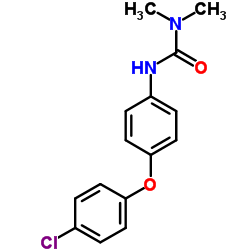Chloroxuron

Chloroxuron structure
|
Common Name | Chloroxuron | ||
|---|---|---|---|---|
| CAS Number | 1982-47-4 | Molecular Weight | 290.745 | |
| Density | 1.3±0.1 g/cm3 | Boiling Point | 459.3±41.0 °C at 760 mmHg | |
| Molecular Formula | C15H15ClN2O2 | Melting Point | 151ºC | |
| MSDS | Chinese USA | Flash Point | 231.6±27.6 °C | |
| Symbol |


GHS07, GHS09 |
Signal Word | Warning | |
| Name | chloroxuron |
|---|---|
| Synonym | More Synonyms |
| Density | 1.3±0.1 g/cm3 |
|---|---|
| Boiling Point | 459.3±41.0 °C at 760 mmHg |
| Melting Point | 151ºC |
| Molecular Formula | C15H15ClN2O2 |
| Molecular Weight | 290.745 |
| Flash Point | 231.6±27.6 °C |
| Exact Mass | 290.082214 |
| PSA | 41.57000 |
| LogP | 3.20 |
| Vapour Pressure | 0.0±1.1 mmHg at 25°C |
| Index of Refraction | 1.618 |
| Stability | Stable. Incompatible with strong oxidizing agents. |
CHEMICAL IDENTIFICATION
HEALTH HAZARD DATAACUTE TOXICITY DATA
|
| Symbol |


GHS07, GHS09 |
|---|---|
| Signal Word | Warning |
| Hazard Statements | H332-H400 |
| Precautionary Statements | P273 |
| Personal Protective Equipment | Eyeshields;Faceshields;Gloves |
| Hazard Codes | N: Dangerous for the environment; |
| Risk Phrases | 50/53 |
| Safety Phrases | 60-61 |
| RIDADR | UN3077 9/PG 3 |
| RTECS | YS6125000 |
| HS Code | 2924299034 |
| Precursor 0 | |
|---|---|
| DownStream 1 | |
| HS Code | 2924299034 |
|---|---|
| Summary | 2924299034 n-(3-chloro-4-methylphenyl)-2-methylpentanamide。supervision conditions:s(import or export registration certificate for pesticides)。VAT:17.0%。tax rebate rate:9.0%。MFN tarrif:6.5%。general tariff:30.0% |
|
Electrically driven microseparation methods for pesticides and metabolites. II: on-line and off-line preconcentration of urea herbicides in capillary electrochromatography.
Electrophoresis 20(12) , 2337-42, (1999) Capillary electrochromatography (CEC) was introduced to the separation of nine important urea herbicides using octadecyl-silica (ODS) capillary columns that were specially designed to allow the realiz... |
|
|
Photocatalytic degradation of phenyl-urea herbicides chlortoluron and chloroxuron: characterization of the by-products by liquid chromatography coupled to electrospray ionization tandem mass spectrometry.
Rapid Commun. Mass Spectrom. 20(10) , 1569-76, (2006) The first stages of the photocatalytic degradation of the compounds chlortoluron [3-(3-chloro-4-methylphenyl)-1,1-dimethylurea] and chloroxuron [3-[4-(4-chlorophenoxy)phenyl]-1,1-dimethylurea], belong... |
|
|
Determination of chloroxuron in strawberries using liquid chromatography with electron-capture detection.
Bull. Environ. Contam. Toxicol. 35(6) , 711-5, (1985)
|
| Urea, N'-[4-(4-chlorophenoxy)phenyl]-N,N-dimethyl- |
| Gesamoos |
| N’-[4-(4-chlorophenoxy)phenyl]-N,N-dimethylurea |
| Caswell No. 217B |
| TENORAN |
| 3-[4-(4-Chlorophenoxy)phenyl]-1,1-dimethylurea |
| Ciba 1983 |
| Chloroxuron |
| Norex |
| Chlorphencarb |
| Chloroxifenidim |
 CAS#:103-70-8
CAS#:103-70-8